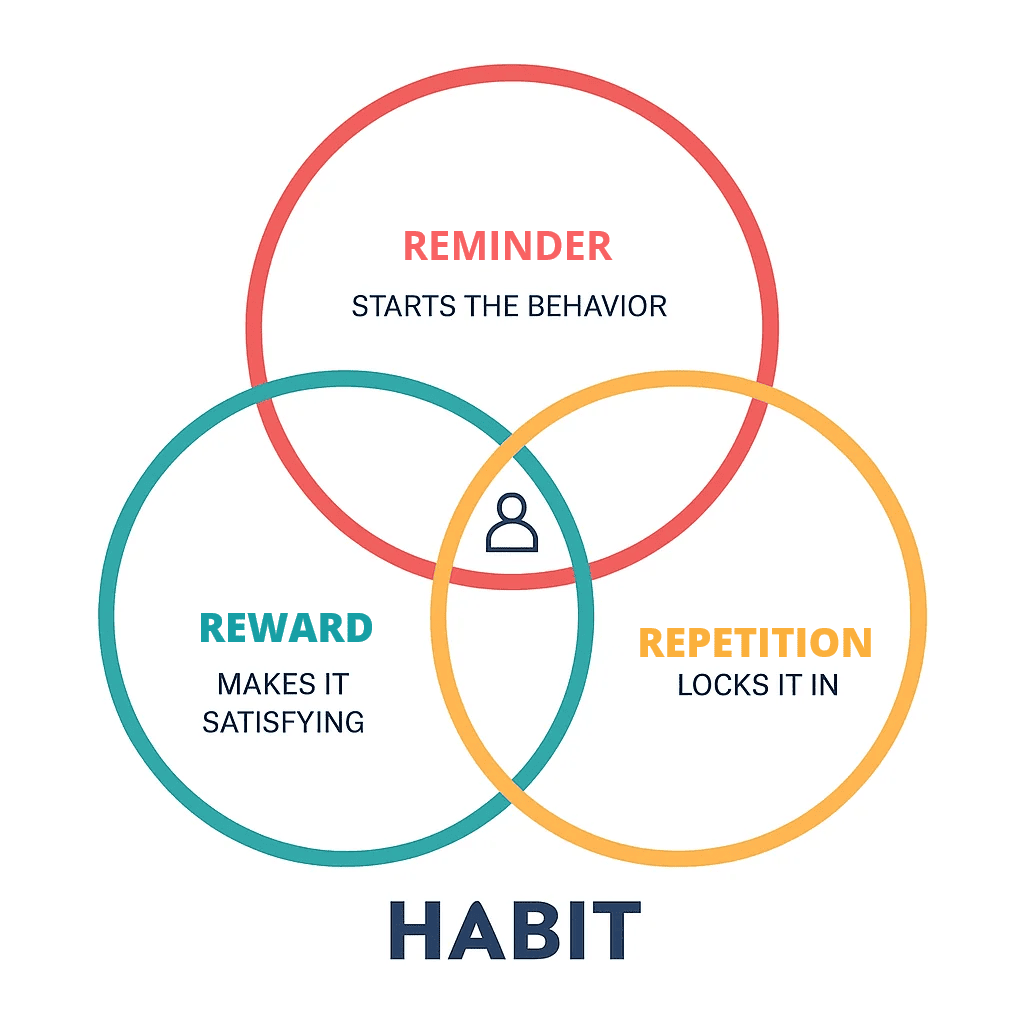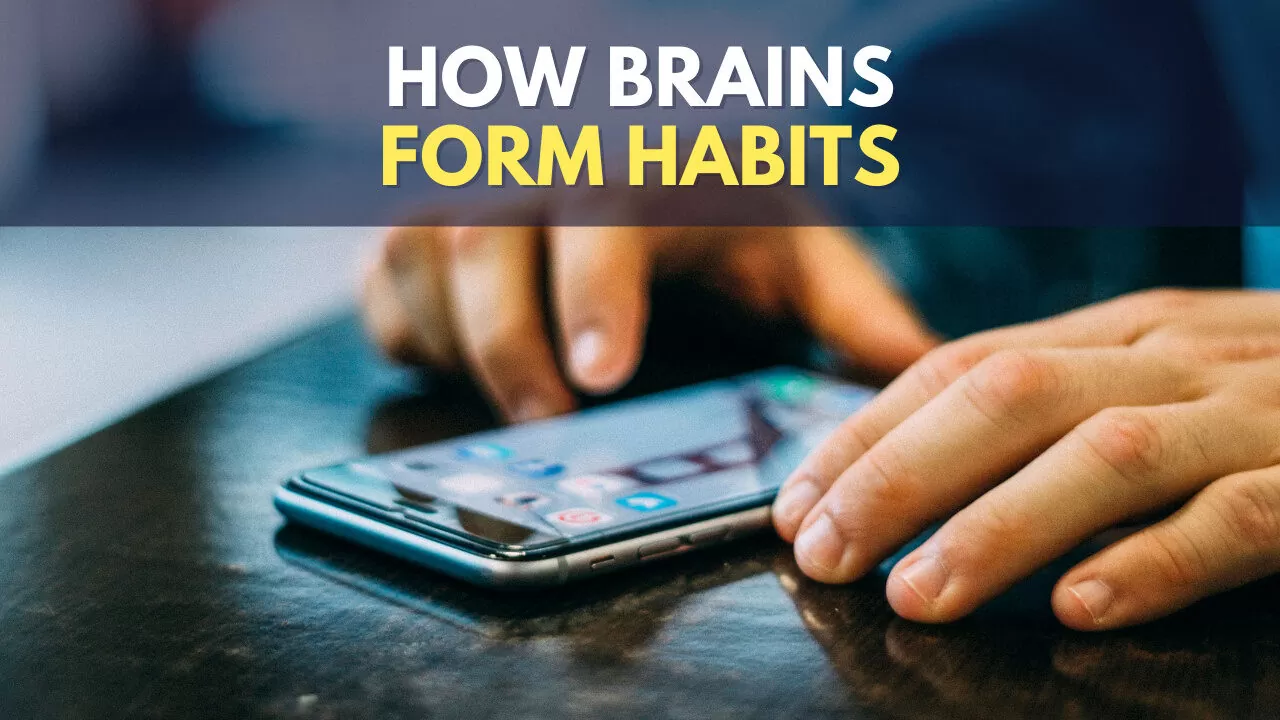Today's Saturday • 7 mins read
Most of us rely on willpower to form good new habits or break old bad habits. But it doesn’t work. Neither does motivation.
First, willpower comes in limited supply. It can’t always save us from repeating a bad habit. And second, motivation doesn’t last as we go through life’s different phases.
Now, habits are automatic behaviors, or activities that happen at our subconscious level.
Psychologists tell us that if we reverse-engineer how our brains create these automatic behaviors, we can make or break habits without relying much on willpower or motivation.
3 R’s of Habit Formation
3 R’s of habit building that many psychologists and behavior experts describe:
- Reminder (Trigger): What starts the behavior.
- Routine (Action): The action itself, repeated over time.
- Reward: The payoff that makes your brain want to do it again.
Different authors use slightly different words, but the underlying cycle is the same: Trigger → Action → Reward.

The sequence is Trigger → Action → Reward because of how the brain’s habit loop works in real time:
- Trigger (Cue): Something in your environment or inside you (like a time of day, place, or feeling) signals your brain that a behavior should start. Example: Your phone buzzes with a notification.
- Action (Routine): This is the behavior you actually perform in response to the trigger. Example: You pick up the phone and check the message.
- Reward: The payoff comes after the action. Your brain receives a hit of satisfaction, relief, or pleasure, which reinforces the likelihood that you’ll repeat the action when the same trigger shows up again.
Example: You feel good seeing a funny meme or connecting with a friend.
Action/Repetition comes before Reward, because the reward teaches your brain that the action was worth repeating, and thus it forms the habit.
How Are Habits Formed In The Brain?
Habit formation is not a standalone behavior. It has 3 steps that move in a cycle:
- Dopamine Seeking: Our brains are wired to seek dopamine, a neurotransmitter associated with pleasure and reward. This makes us want to do things that will give us a sense of enjoyment.
- Behavior Execution: When we perform a specific behavior (the action), our brain releases dopamine as a reward for that action. This release creates a positive feeling, which reinforces the behavior and makes us more likely to do it again.
- Reward Association: The brain links the action to the reward, creating a reward-dopamine-pleasure loop. The action and the positive feelings that result strengthen over time, making it more and more desirable to repeat the action.
- Cue-Action-Reward Cycle: As the habit begins to form, a sequence emerges: a cue (or trigger) calls for the action, which is followed by the reward. This cycle reinforces the habit, as the brain learns to expect the reward following the action initiated by the cue.
So, the habit formation cycle through:
- Cue — a trigger that fires the desire to do an action
- Action — daily or more frequent repetition of that behavior
- Reward — giving or receiving a reward for completing the behavior
How To Harness The Habit Cycle To Break Bad Habits
- Identify the cues that trigger your unwanted behavior. Cues can be external, such as specific times of day, locations, or social situations, or internal, such as emotions or thoughts.
- Build a trigger awareness to help anticipate and be vigilant of when you are likely to carry out the habit you wish to break.
- Create a replacement plan to substitute the unwanted action with a better behavior. As soon you notice the cue, you would consciously push yourself to choose the alternative behavior.
- Reward yourself for carrying out this alternative behavior. This is the crux action. Celebrate the success of having replaced the bad with the good.
- Keep at it consistently. Over time, with many repetitions, this new habit will become an unconscious habit, meaning you won’t need conscious deliberations to push yourself to do it.
Example: You have a bad habit of reaching for a sugary afternoon snack at work. Here’s how you could use the Cue-Action-Reward cycle to break this habit:
Step 1: Identify the Cues
- Time-based cue. The cue is the specific time of day—afternoon—when you feel a dip in energy.
- Environment-based cues could be being in the break room or seeing colleagues enjoying snacks.
- Emotion-based cues could be stress or boredom.
Step 2: Build Trigger Awareness
- Start a journal to track your urges — the time, your emotional state, and the setting.
- You’ll find a pattern emerge. This will help you anticipate and prepare to say No at those times.
Step 3: Create A Replacement Plan
- Keep a small container of mixed nuts, yogurt, or sliced fruit on your desk.
- When the cue hits, force yourself to choose this healthier replacement behavior.
Step 4: Reward Yourself
- Pat your back for keeping your commitment to healthy eating
- Treat yourself to a non-food reward, like a few minutes of your favorite music
- Talk to someone you like, go for a short walk outside, or take a siesta for a few minutes
Rewards help anchor the new behavior in your brain.
Step 5: Keep at It Consistently
- Keep practicing this replacement strategy every time you get an afternoon cue.
- Eventually, you would just reach out for the healthier food without even thinking about any sugary snack.
Where Does Habit Live In The Brain
Habit lives in the basal ganglia of the brain.
Any new behavior begins with conscious deliberation and intention, governed by our brain’s executive function, often referred to as ‘System 2’—the prefrontal cortex.
This region is responsible for complex cognitive tasks, such as solving math problems, learning a foreign language, or navigating unfamiliar environments.
As we consistently repeat a behavior over time, our brain gradually shifts from relying on the executive function to becoming dependent on the basal ganglia, a more primitive area of the brain.
This transition allows the behavior to become automatic, meaning we no longer need to consciously think about initiating or continuing it.
Eventually, we are no longer conscious of the behavior and carry it effortlessly, without the need for deliberate thought or intention.

Habit Modification Strategies
Two primary strategies that modify our habits are:
- Reinforcement by Reward: In this, we give a reward to instill any good behavior.
- Prevention by Punishment: In this, we give punishment to stop any unacceptable behavior.
The punishment strategy is something we all know of. When we were kids, our parents or teachers may have used this on many of us.
However, the punishment strategy doesn’t work as well as the reward system. Rewards are more effective than punishment, suggest researchers (Dreber & Rand, Winners don’t punish. Nature, 2008).
The more effective reward-reinforcement method can help both establish and break bad habits.
It works around the idea that we set up many goalposts to reach the final point of our desired behavior change. And reward ourselves each time we reach these goalposts.
A Habit Is Many Tasks
A habit is defined as a sequence of tasks that we learn to perform unconsciously and automatically in response to certain cues or triggers.
Note the three things in that definition:
- It’s not a single task, but a series of interrelated activities.
- We do it automatically, mostly without any conscious intervention.
- We perform habitual actions in reaction to triggers in our environment, much like Pavlov’s dogs.
Habits can be best explained as learned automatic responses with specific features (Wood et al., 2014). Habits get activated in memory autonomously without needing any executive control from the higher brain (Evans & Stanovich 2013).
Final Words
Habits can cause us to eat unhealthy foods mindlessly.
In a study conducted at a local cinema, participants with stronger habits of eating popcorn at the movies ate more than those with weak habits, even when they disliked the popcorn because it was stale and unpalatable. (The Pull of The Past, Neal et al., 2011).
Finally, don’t stop trying if you fail at avoiding a bad habit once or twice. These failed attempts have fine-tuned your result-achieving brain mechanism called psycho-cybernetics.
Remember, no failure is final until you stop trying.
• • •
√ Also Read: First Principles Thinking: Elon Musk’s Way To Solve Problems
√ Please spread the word if you found this helpful.
» You deserve happiness! Choosing therapy could be your best decision.
...
• Disclosure: Buying via our links earns us a small commission.